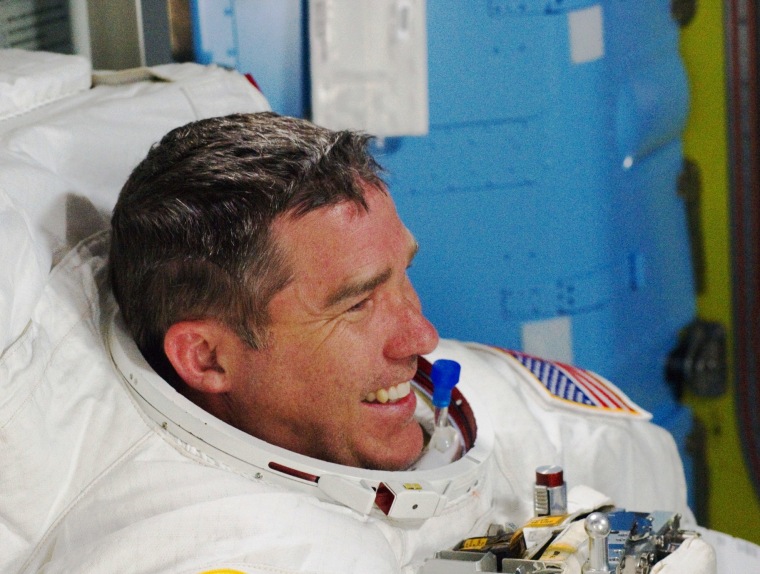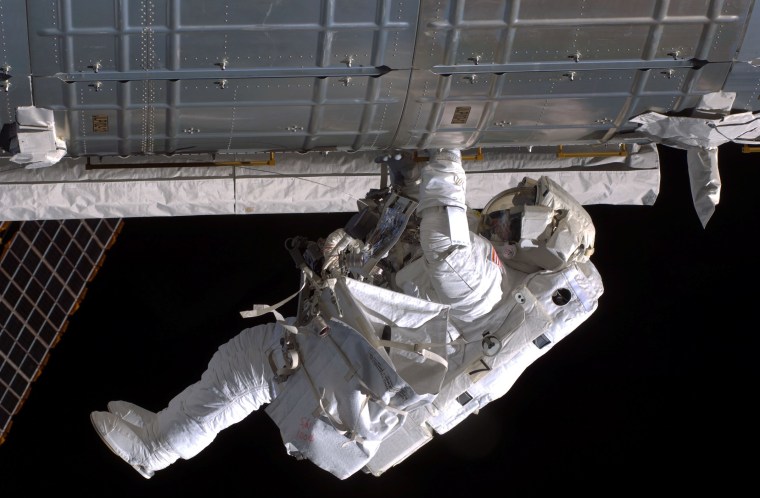NASA has named a substitute crew member for its next scheduled shuttle mission, due to a weekend bike accident that left the Discovery flight's lead spacewalker with an injured hip.
Astronaut Steve Bowen, who flew on the shuttle Atlantis last May during the most recent shuttle outing, will take the place of injured spacewalker Tim Kopra, NASA said Wednesday. That would make Bowen the first NASA astronaut to fly on back-to-back shuttle missions.
Bowen also flew on a November 2008 mission to the International Space Station, which would make the upcoming mission his third shuttle flight in 27 months — assuming, of course, that Discovery launches on Feb. 24 as scheduled.
NASA managers decided to stick to the schedule for Discovery's mission, known as STS-133, even though that would give Bowen just a few weeks to practice for the mission's two spacewalks.

"Steve is an ideal candidate, and we have complete confidence he'll contribute to a fully successful STS-133 mission," Peggy Whitson, chief of the Astronaut Office at NASA's Johnson Space Center, said in a statement announcing the switch. "He has performed five prior spacewalks. That extensive experience, coupled with some adjustments to the spread of duties among the crew, will allow for all mission objectives to be accomplished as originally planned in the current launch window."
During the shuttle program's nearly 30-year history, there have been about two dozen cases in which a shuttle crew member has been replaced, due to medical, logistical or personal reasons. "But none of the earlier replacements were anywhere as close to launch as this case," NBC News space analyst James Oberg said Wednesday in an e-mail about the switch.
Robot on the crew
The February mission is aimed at bringing tons of supplies and equipment to the space station, including a humanoid robot called Robonaut 2. An Italian-built storage module would be installed onto the station, and spacewalkers are scheduled to move equipment and hook up cameras on the station's exterior.
Kopra was due to take the lead role on the spacewalks, but on Saturday, NASA reported that he was hurt in a bicycle accident. The space agency said the injury was not life-threatening. Further details on his medical condition were not released officially, due to privacy concerns, but unofficial reports suggested that Kopra had broken his hip.
"Tim is doing fine and expects a full recovery, however, he will not be able to support the launch window next month," Whitson said. "If for some unanticipated reason STS-133 slips significantly, it is possible that Tim could rejoin the crew."
Astronaut Alvin Drew is to serve as the mission's other spacewalker. Other crew members include commander Steven Lindsey, pilot Eric Boe and mission specialists Michael Barratt and Nicole Stott. Kopra's non-spacewalking duties would be distributed among the crew, NASA said.
Repeated delays
Discovery's launch was initially planned for last November — but the flight has been repeatedly delayed, primarily due to problems with support ribs on Discovery's external fuel tank. NASA engineers are currently reinforcing the ribs, with the repair work scheduled to be complete in time for a Feb. 24 liftoff.
STS-133 would be Discovery's final spaceflight, to be followed by Endeavour's last flight in April. As the schedule currently stands, the April flight would close out the shuttle program. Another shuttle mission has been authorized by Congress, but NASA says lawmakers still have to appropriate the funding to support an extra launch for the shuttle Atlantis.
After this year's retirement of the shuttle fleet, NASA will have to depend on space transports provided by other countries, principally Russia.
The space agency is also supporting the development of commercial spaceships that could transfer cargo and eventually crew members into orbit.
Bowen's status as a back-to-back shuttle flier sent space historians to the record books. Although Bowen would be the first American on two successive space crews, Russian cosmonaut Vladimir Dzhanibekov flew back-to-back Soyuz flights in July 1984 and June 1985.
"The second mission was an emergency repair to the Salyut 7 space station, and he was picked for the same reason Bowen was picked — most recently flown, and experienced," Oberg observed.
